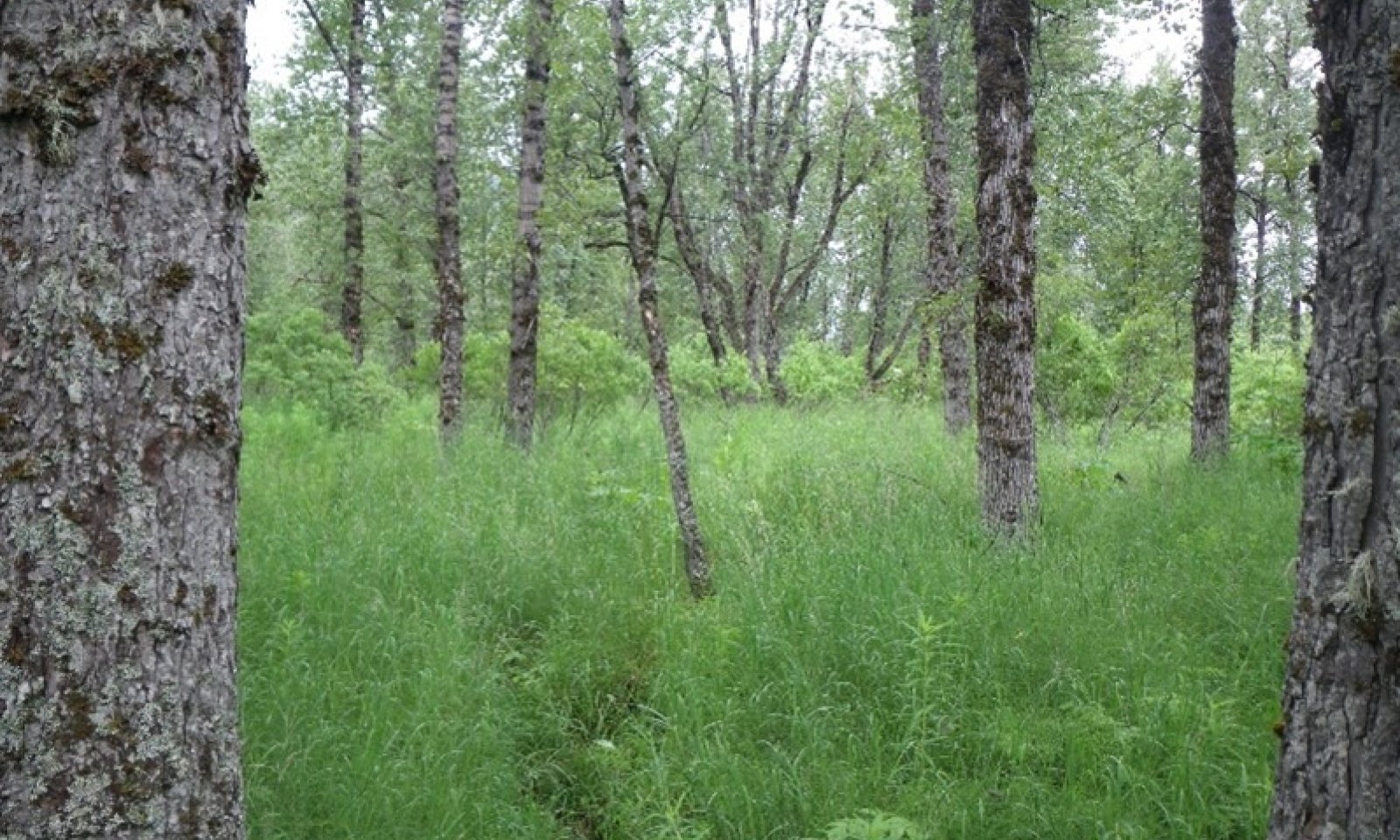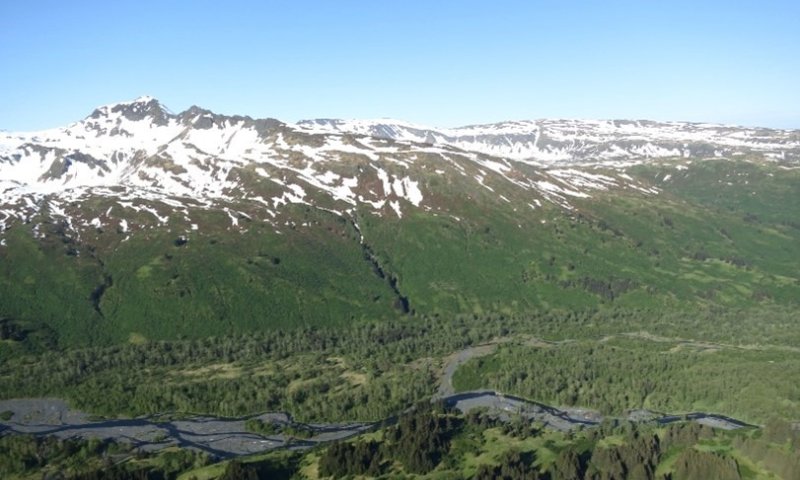

Natural Resources
Conservation Service
Ecological site F225XY310AK
Southern Alaska Riparian Complex Flood Plains
Last updated: 6/14/2025
Accessed: 10/19/2025
General information
Provisional. A provisional ecological site description has undergone quality control and quality assurance review. It contains a working state and transition model and enough information to identify the ecological site.
MLRA notes
Major Land Resource Area (MLRA): 225X–Southern Alaska Peninsula Mountains
Major Land Resource Area 225X (Southern Alaska Peninsula Mountains), herein called area, is in the Southern Alaska Land Resource Region (LRR). MLRA 225X covers approximately 23,935 square miles of the southern parts of the Kodiak Archipelago and the slopes of the southern Aleutian Mountains on the Alaska Peninsula. The landscape is comprised of rugged mountains separated by narrow valleys, with outwash plains and low hills towards the coast. Glaciers and ice fields cover the highest mountains. Flood plains are predominantly restricted to broad river valleys. Elevations range from sea level to 9,372 feet at the summit of Shishaldin Volcano. The soils and vegetation in this MLRA have been influenced by ash deposits from nearby Mount Katmai and surrounding volcanoes. This MLRA is primarily comprised of wilderness, with towns and villages primarily located along rivers, lakes, and the coast. Small villages are scattered along the coastline and include King Cove, Old Harbor, Karluk, and Larsen Bay among others. There is no road access to MLRA 225X from Anchorage, AK, and access is primarily via plane or boat.
MLRA 225X, excluding high peaks and steep upper backslopes, was glaciated during the Late Pleistocene. Glacial deposits were eroded or covered by colluvium or alluvium during the Holocene, which comprises 60 percent of the current landscape. Modified glacial moraines and outwash landforms are prevalent. Volcanic activity continues through the present day, and ash deposits are represented in many of the soils of this MLRA.
The dominant soil orders are Andisols, Histosols, and Inceptisols. Soils have a cryic temperature regime or subgelic soil temperature class, an aquic or udic soil moisture regime, and primarily amorphic mineralogy. Permafrost is sporadic in the Southern Alaska LRR. The primary soils in this MLRA developed from volcanic ash over colluvium or from thick organic material. Miscellaneous (non-soil) areas comprise greater than 50 percent of all acreage in this MLRA and includes “rock outcrops, rubble land, glaciers, riverwash, and beaches” (USDA-NRCS, 2022).
The climate in this MLRA is shaped by maritime influences from Bristol Bay to the west and the Pacific Ocean to the south. Mountains effect local patterns in temperature and precipitation. Temperatures are typically cool throughout the year. The mean annual temperature at sea level is 37 to 43 degrees Fahrenheit. Precipitation ranges from 30 inches along the coast to over 100 inches at high elevations. Snowfall ranges from 50 to 200 inches and glaciers and icefields are present at higher elevations.
This MLRA is dominated by tall alder and willow shrubs at lower elevations. Vegetation shifts to low and then dwarf shrubs at increased elevations. Herbaceous communities are on exposed plains and hills, and sedges dominate wet depressions. Balsam poplar forests are restricted to flood plains and warm, low mountain slopes in the northern parts of the MLRA (USDA-NRCS, 2022).
LRU notes
MLRA 225X supports three life zones delineated by the physiological limits of plant communities along longitudinal and elevational gradients: Aleutian, South Alaska maritime, and South Alaska alpine. The Aleutian climate covers hills of the southern Kodiak archipelago and on the extended Alaska Peninsula. These regions are low-lying, exposed and are scoured by winter winds. Vegetation is primarily low shrublands, heathlands and often diverse herbaceous meadows. The South Alaska maritime climate is common in mountainous areas where local site conditions delineate alpine and lowland areas. Certain vascular plant species are common in the lowlands and much less common in the alpine (i.e. Populus balsamifera, Alnus spp., Salix pulchra, Betula nana, Ledum palustre ssp. decumbens, and Calamagrostis canadensis). The alpine generally occurs at elevations above 1,500 feet, though may extend higher on warm, north-facing slopes, and lower on cooler slopes. Vascular plants are restricted in height and often exclude common lowland species. The transition between South Alaska maritime and alpine vegetation can occur within a range of elevations, and is highly dependent on latitude, slope, aspect, and shading from adjacent mountains.
Classification relationships
Landfire Biophysical Settings – 7617280 – Aleutian Floodplain Forest and Shrubland (Landfire, 2009)
The Alaska Yukon Region of the Circumboreal Vegetation map (CBVM) – Southern Alaska Floodplain Spruce-Cottonwood Forests and Scrub (Jorgensen and Meidinger, 2015)
Viereck Communities:
Forested RPC: Level III - Closed broadleaf forest (I.B.1) / Level IV – Balsam poplar closed forest (I.B.1.c)
Post-flood scrubland: Level III – Closed tall scrub (II.B.1) / Level IV – Willow scrubland (II.B.1.a)
(Viereck et al., 1992)
Kodiak Archipelago Land Cover Classification:
Class 11 – Dense cottonwood forest
Class 56 – Tall willow
(Fleming and Spencer, 2007)
Ecological site concept
Ecological Site concept:
• Occurs on the flood plain riparian complex including low and high flood plains
• Supports a closed broadleaf forest in the reference plant community (Viereck et al., 1992)
• Soils derived from alluvial parent material
• Higher flood plain soils are well drained with an udic moisture regime. Low flood plains are poorly drained with an aquic moisture regime.
• Flooding is frequent in low areas and occasional in high areas. Areas proximal to the flood source experience higher energy flooding
• More frequently flooded areas are associated with low flood plains that support a scrubland community. Less frequently flooded areas are associated with high flood plains that support a forest
Associated sites
| R225XY313AK |
Southern Alaska Scrub Loamy Oxbows Oxbows on flood plains. |
|---|---|
| F225XY315AK |
Southern Alaska Forest Loamy Terraces Forested terraces in broad mountain valleys. |
| F225XY360AK |
Southern Alaska Forest Loamy Hill Backslopes Forests on low elevation mountain slopes. |
Similar sites
| F225XY315AK |
Southern Alaska Forest Loamy Terraces R225XY315AK describes stream terraces that do not flood. There is no post-flood scrubland on terraces as found on flood plains. |
|---|---|
| F225XY360AK |
Southern Alaska Forest Loamy Hill Backslopes R225XY360AK describes deciduous forests on lower mountain slopes that do not flood. |
Table 1. Dominant plant species
| Tree |
(1) Populus balsamifera |
|---|---|
| Shrub |
(1) Salix |
| Herbaceous |
(1) Calamagrostis canadensis |
Click on box and path labels to scroll to the respective text.
Ecosystem states
State 1 submodel, plant communities
| 1.1A | - | Flooding to primary succession |
|---|---|---|
| 1.2A | - | Natural succession |
| 1.2B | - | Flooding |
| 1.3A | - | Post-flood recovery |

